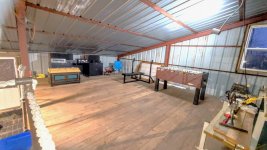If I needed to make a frame out of metal which would be used to mount boards for a bench/table top, what would be the best material to make it out of to resist twisting (i.e. where one or opposite corners want to twist)? Angle, rect tube, round tube, something else? And what should the cross-member design look like for best resistance to said twisting? The outer dimensions are 7' x 3.5'.
I'm thinking something like 2x4 1/4" wall rectangular tube for the perimeter and 2.5" or 3" angle iron for cross-members. But is a ladder style of cross-member best or would some type of X be better?
The reason I'm looking into this is that I have 3" thick x 15" maple beams I'm going to use for the top and they all have a twist to them. No, I can't plane the twist out of them. Yes, they are dry like this. Rigidity is the main concern. Cost isn't the primary factor. I've tried a wood frame but the top beams pull up opposite corners about 1/2". 120# of weight on each corner flattens it out nice but that's not a solution. It's been 30 years since I took mechanical engineering classes in college and I don't recall enough to figure it out.
I'm thinking something like 2x4 1/4" wall rectangular tube for the perimeter and 2.5" or 3" angle iron for cross-members. But is a ladder style of cross-member best or would some type of X be better?
The reason I'm looking into this is that I have 3" thick x 15" maple beams I'm going to use for the top and they all have a twist to them. No, I can't plane the twist out of them. Yes, they are dry like this. Rigidity is the main concern. Cost isn't the primary factor. I've tried a wood frame but the top beams pull up opposite corners about 1/2". 120# of weight on each corner flattens it out nice but that's not a solution. It's been 30 years since I took mechanical engineering classes in college and I don't recall enough to figure it out.




